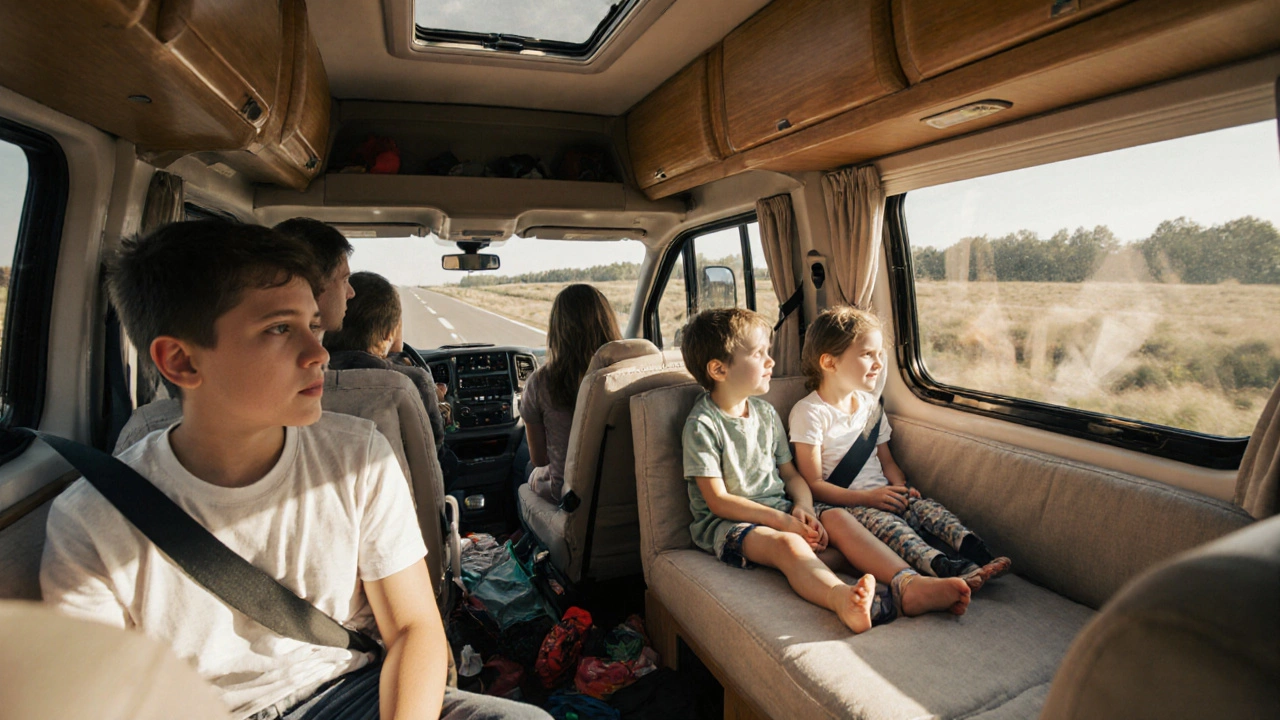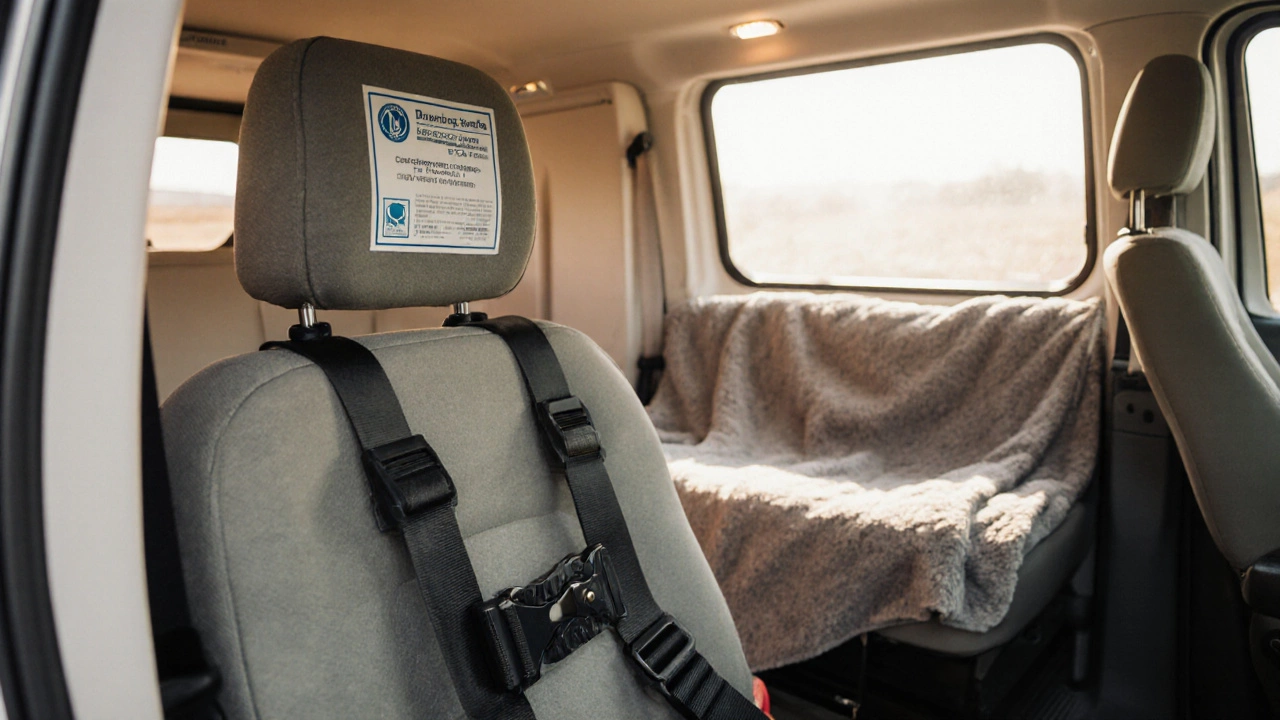Is It Safe to Ride in the Back of a Motorhome? What You Need to Know Before You Go
 Nov, 20 2025
Nov, 20 2025
It’s a sunny Saturday morning. You’ve packed the kids, the dog, the snacks, and the camping gear. The motorhome’s full, the road’s open, and someone in the back shouts, “Can I sit here and watch the scenery?” You glance back-no seatbelts, no proper seats, just a padded bench with a view. You hesitate. Is it really safe to ride in the back of a motorhome?
It’s not just about comfort-it’s about the law
In most countries, including Australia, the UK, Canada, and across the EU, riding in the back of a motorhome without a proper seat and seatbelt is illegal. It doesn’t matter if you’re going slow, if it’s just for a few minutes, or if the kids are asleep. The rules aren’t suggestions-they’re enforced by traffic police and backed by crash data.
Australia’s road transport laws require every passenger to have a designated seating position with a properly fitted three-point seatbelt. That means no standing, no sitting on fold-out beds, no perching on the dinette table. Even if your motorhome has a rear bench, if it wasn’t factory-installed as a certified passenger seat, it’s not legal to use it while driving.
Same goes for the UK. The Highway Code clearly states: “All passengers must wear seatbelts where fitted.” The Department for Transport has fined families over £500 for having children unrestrained in the back of a motorhome during travel. Insurance companies also routinely deny claims if passengers weren’t properly belted-no matter who was at fault in the crash.
What happens in a crash?
Let’s say you’re driving at 60 km/h-typical highway speed-and you hit a sudden stop. A 40 kg child sitting on a sofa in the back becomes a 1,200 kg projectile. That’s not a metaphor. Physics doesn’t care if you’re on vacation.
Crash tests by the Australian Road Safety Foundation show that unrestrained passengers in motorhomes are 12 times more likely to suffer serious injury or death than those in approved seats. The back of a motorhome isn’t designed to absorb impact. It’s made for lounging, not surviving a collision.
Real-life case: In 2023, a family in Western Australia was involved in a rollover. Two children were sitting on a rear bench without seatbelts. One was thrown through the rear window. The other suffered a spinal injury. Both survived-but only because a passing motorist stopped and called emergency services. The driver was fined, and the insurance company refused to cover medical costs because the children weren’t properly restrained.
What counts as a “proper seat”?
Not every bench is a seat. A proper passenger seat in a motorhome must have:
- A manufacturer-approved mounting system (bolted to the chassis, not just the floor)
- A three-point seatbelt (lap and shoulder)
- A label or certification mark (like ECE R44/04 or R129 i-Size)
- Designed for use while the vehicle is moving
Many motorhomes have rear benches that look like seats-but they’re only meant for when the vehicle is parked. These are called “travel seats” only if they meet the above standards. If you bought your motorhome secondhand, check the manual or ask the manufacturer. If you can’t find proof it’s certified, assume it’s not safe.
Some motorhomes come with optional rear seats that can be installed by the dealer. If you’re buying a used motorhome and the rear bench doesn’t have seatbelts, don’t assume they were removed. They were probably never installed. Retrofitting seatbelts is possible-but only by certified vehicle modifiers. DIY seatbelt installations won’t pass inspection and won’t save lives.

What about older motorhomes?
Motorhomes built before 1990 often had no seatbelts in the rear at all. That doesn’t make it legal today. Laws don’t grandfather in unsafe practices. Even if your 1985 Winnebago never had seatbelts in the back, you’re still required to follow current safety standards. The only legal option? Don’t let anyone ride there while moving.
Some owners retrofit rear seats with certified seatbelts. It’s expensive-usually $1,500-$3,000 AUD-but it’s the only way to make an older motorhome compliant. If you’re planning a long trip with kids, this isn’t a luxury-it’s a necessity.
What about the front passenger seat? Is that safe?
Yes-if it’s designed for it. Front seats in motorhomes are almost always certified for travel. They have seatbelts, airbags (in newer models), and proper mounting. That’s where everyone should be seated while driving.
Never let kids sit in the front if there’s an active airbag unless they’re in a certified child restraint. Airbags deploy at over 200 km/h. A 5-year-old in a booster seat can be seriously injured-or killed-by an airbag that’s meant for adults.
What are the alternatives?
If you’ve got more people than certified seats, you’ve got a problem. And the solution isn’t to bend the rules-it’s to plan better.
- Choose a motorhome with more certified seats. Many modern models have 6-7 certified travel positions.
- Use a towed vehicle. Bring a small car or SUV behind your motorhome. Load kids and extra gear there.
- Split your group. Two vehicles are better than one overloaded motorhome.
- Travel with fewer people. Sometimes, leaving one person behind makes the trip safer and more enjoyable.
Some families think they’re saving money by cramming everyone into one vehicle. But if you get fined, your insurance gets denied, or worse-someone gets hurt-the cost skyrockets. A second car rental for a week might cost $600. A hospital bill for a child’s spinal injury? That’s $50,000 minimum.

What do experts say?
The Royal Automobile Club of Australia (RAC) and the UK’s Royal Society for the Prevention of Accidents (RoSPA) both say: “If there’s no seatbelt, no one should sit there.”
Motorhome manufacturers like Winnebago, Coachmen, and Hymer all design their certified seats to meet international safety standards. They don’t recommend using non-certified areas for travel. Their manuals are clear: “Passengers must be seated and belted in approved seating positions during travel.”
Even the RV Industry Association in the U.S. runs public safety campaigns warning families not to ride in the back. They’ve partnered with child safety groups to produce videos showing crash simulations. The results are graphic-and unforgettable.
What if everyone says it’s fine?
“Everyone does it” is the most dangerous excuse on the road.
Maybe your cousin’s motorhome has a rear bench and they’ve never had an accident. But that’s luck, not safety. One second of distraction, one patch of gravel, one swerve to avoid a kangaroo-it’s all it takes. And when that moment comes, no one will care that “everyone does it.”
Don’t let peer pressure override common sense. Your kids aren’t asking to ride in the back because it’s fun-they’re doing it because they think it’s normal. It’s your job to make it normal to be safe.
Bottom line: Don’t risk it
Motorhome holidays are meant to be fun, relaxing, and memorable. They shouldn’t be defined by a hospital visit or a court fine.
If your motorhome doesn’t have enough certified seats for everyone, don’t drive with extra passengers in the back. It’s illegal. It’s dangerous. And it’s not worth the risk.
Plan ahead. Choose the right vehicle. Rent a second car if you have to. Make safety your first stop before every trip. Because the best vacation is the one where everyone comes home.
Can I sit in the back of a motorhome if I’m wearing a seatbelt?
Only if the seat itself is certified for travel. A seatbelt alone isn’t enough. The seat must be factory-installed, bolted to the chassis, and labeled as a certified passenger seat. Many rear benches are meant for parking only-even with a seatbelt attached. If you can’t find proof it’s approved for travel, don’t use it.
Are there any countries where it’s legal to ride in the back of a motorhome?
No major country allows unrestrained travel in non-certified areas. Some places, like parts of the U.S., have looser enforcement in rural areas, but the law still requires seatbelts in all designated seating positions. Even in countries with less strict policing, insurance claims will be denied if passengers weren’t properly restrained. The law is universal: if there’s no approved seat and belt, no one should be sitting there.
Can I install seatbelts in the back of my motorhome myself?
No. Seatbelt installations must be done by a certified vehicle modifier who follows national safety standards. DIY installations won’t pass inspection, won’t be covered by insurance, and may actually make the vehicle less safe. Improperly mounted belts can tear free in a crash or cause internal injuries. Always use a professional.
What if my motorhome only has two seatbelts but I have four people?
Only two people can legally ride in the motorhome while driving. The others must travel in a separate vehicle. There’s no exception for family trips, short distances, or sleeping passengers. Overloading your motorhome puts everyone at risk-and breaks the law. Consider renting a small car or towing a trailer for extra passengers.
Do I need child car seats in a motorhome?
Yes. Children must use the same car seats or boosters they’d use in a regular car. A motorhome isn’t exempt from child restraint laws. In Australia, kids under 7 must use an approved child restraint. The seatbelt must be properly fitted around the child’s harness or booster. Never use a regular seatbelt alone for a child under 145 cm tall.